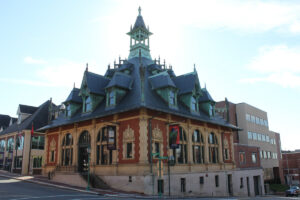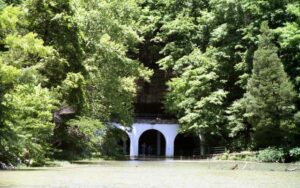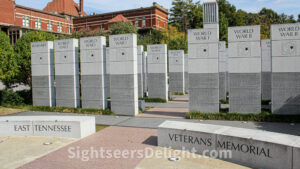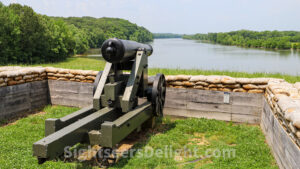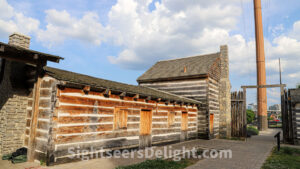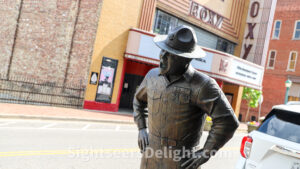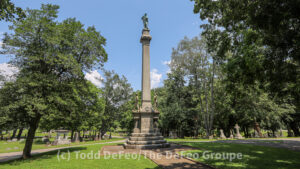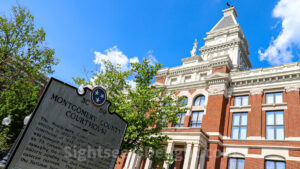In 1898, the federal government built a customs house and a post office at the corner of Second and Commerce streets to help process the increasing volumes of mail to and from the city. In 1984, the building was transformed into the Customs House Museum and Cultural Center touted as the state’s second-largest general interest museum. The museum features a number of permanent exhibits, including the postmaster’s office and Memory Lane, dedicated to telling the story of Clarksville and Montgomery County’s history.
37040
By the 1930s and 1940s, Dunbar Cave was a popular destination, not so much because of its natural splendor, but because of the musical acts that performed at the cave entrance. The 8-mile-long Dunbar Cave was formed millions of years ago and has always attracted people. During digs at the site, archeologists found Paleo-Indian artifacts buried near the cave entrance, and in 2005, Indian glyphs were discovered on the cave walls.
37043
The East Tennessee Veterans Memorial includes 32 granite monuments with inscribed names of more than 6000 veterans from 35 counties in East Tennessee who have died in military service since World War I. The memorial lists names by conflict and by county. The memorial, located on a grassy plot at the northern end of Knoxville’s World’s Fair Park, also includes the names of the 14 Medal of Honor recipients from East Tennessee. Other features are a plaza entrance with a 50-foot flag pole and a 27-foot high bell tower.
37902
Confederate troops in November 1861 built defenses overlooking the Cumberland and Red rivers. Following a major battle at Fort Donelson in nearby Dover, Confederate troops abandoned Clarksville; Union troops later found the abandoned fort and reworked it for their needs. In 2011, the city opened a $2 million interpretive center to tell the story of Fort Defiance. In addition to a movie in the center, visitors can see remarkable well preserved earthworks at the site and take in a newly installed Confederate money exhibit.
37042
Fort Donelson National Battlefield preserves the resources of and tells the stories of the 1862 campaign and battles for Forts Henry, Heiman, and Donelson, and the opening of the Tennessee and Cumberland Rivers. The national park includes Fort Donelson National Cemetery, established in 1867, as the final resting for Union soldiers and sailors initially buried in the Fort Donelson area. It contains the remains of 670 Civil War burials and roughly 909 veterans from other wars. Dover Hotel, the Surrender House, was built between 1851 and 1853 and served riverboat travelers before and after the Civil War. Confederate Brig. General Simon B. Buckner and his staff used the hotel as their headquarters during the battle. Buckner surrendered to Union Gen. Ulysses S. Grant in the hotel.
37058
Fort Nashborough is a recreation of a stockade established in early 1779 in the French Lick area of the Cumberland River valley. The stockade was a forerunner to a settlement that would become Nashville, Tennessee. The square-shaped log stockade covered 2 acres and contained 20 log cabins. The reconstructed fortification, which stands near the original location, is maintained by Nashville Parks and Recreation.
37201
The city of Clarksville, Tennessee, unveiled the Frank Sutton Statue on Franklin Street in May 2017. Local sculptor Scott Wise created the statue of Sutton, a Clarksville native best known for portraying Sgt. Vince Carter on the 1960s CBS show “Gomer Pyle U.S.M.C.” Sutton in the South Pacific with the U.S. Army during World War II. The statue stands along Franklin Street across from the Roxy Regional Theatre. Sutton, who died in 1974, also appeared in “Gunsmoke” and “The Twilight Zone.”
37040
The historic Montgomery County Courthouse in downtown Clarksville, Tennessee, dates to after the city’s great fire of 1878. Depending on the source, it is either the county’s fourth or sixth courthouse. It was built in 1878-79 to replace an edifice destroyed in the fire, which destroyed much of the city. The “new” courthouse was damaged several times, including during a 1900 fire and a 1999 tornado. Following the tornado, court operations moved to a temporary location on Legion Street (now Strawberry Alley) before moving into its current location. Today, the historic courthouse houses county government offices.
The Hunter Museum of American Art features works representing a range of genres, including American Impressionism, early modernism, regionalism and post World War II modern and contemporary art. The museum, perched on an 80-foot bluff on the edge of the Tennessee River, opened in 1952 and is located in a building represents three distinct architectural stages: the original 1904 classical revival mansion designed by Abram Garfield, the son of president James A. Garfield, which has housed the museum since its opening in 1952, a brutalist addition built in 1975, and a 2005 addition designed by Randall Stout which now serves as the entrance to the museum.
37403

